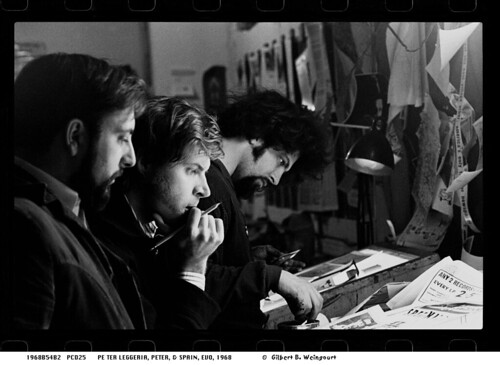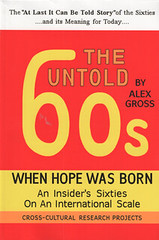Earlier this week, the Arthur L. Carter Journalism Institute launched “Blowing Minds: The East Village Other, the Rise of Underground Comix and the Alternative Press, 1965-72,” with a rousing discussion that’s now archived on the exhibit’s Website, along with new audio interviews with veterans of the Other. Over the course of seven weekend editions of The Local, we’ve heard from all but one of the EVO alumni who spoke on Tuesday’s panel. Here now, to cap off our special series, is the story of Peter Leggieri.
 Gil Weingourt Left to right: Peter Leggieri, Peter Mikalajunas, and Spain Rodriguez.
Gil Weingourt Left to right: Peter Leggieri, Peter Mikalajunas, and Spain Rodriguez.From the first day that I began working at The East Village Other, I was overcome by the sense that it was not only a newspaper but a strange and magical ship on a voyage with destiny. It seemed as though each issue printed was a new port of call, and the trip from one issue to the next, a new adventure. Many of EVO’s crew members expressed that same weird feeling – a sense of excitement and creative power.
And what a crew that was! No one was recruited. I don’t recall a resume ever being submitted. They all simply showed up and started working. EVO’s crew might just have been the greatest walk-on, pick-up team in the history of journalism. She was The Other but her staff of artists, poets, writers, photographers and musicians affectionately called her EVO. Her masthead bore a Mona Lisa eye. EVO created a cultural revolution and won the hearts and minds of a generation. She was the fastest ship in the Gutenberg Galaxy.
In the Beginning
I was the anonymous Other, the one editor-owner unknown to the public. I did not party. I did not schmooze with the literati or seek publicity. I had no time for such things. I worked seven days a week, 20 hours a day and, because of law school, I had to be sober. My friend, the poet John Godfrey, told me that I was afflicted with a Zen curse: a hermit condemned to be surrounded by people and events. That was certainly the case for me in the 1960s. Read more…
Because something is happening here
And you don’t know what it is
Do you, Mister Jones?
– “Ballad of a Thin Man” by Bob Dylan (from “Highway 61 Revisited,” 1965)
 Alan Abramson, 1972.
Alan Abramson, 1972.The times were overwhelming. America was violently awakened from the slumber of the 1950s on Nov. 22, 1963 and quickly found itself inhabiting an unrecognizable, incomprehensible, rapidly evolving reality. The Civil Rights Movement, the Vietnam War, the Free Love Movement, the Women’s Liberation Movement, the Gender Equality Movement, the Consciousness Raising Movement, the Save Our Planet Movement, the Eastern Mysticism Movement, and sex, drugs and rock and roll all conspired to create a giddy, euphoric Renaissance. If you were a nice young person raised in Eisenhower-era suburbia, the questions that consumed you were: “What the hell is going on? What does this all mean? Where do I fit in?” And most importantly: “How do I get invited to the party?”
Enter, The East Village Other. For me it was the Rosetta Stone that enabled me to decode the meaning of the ‘60s. Attending Oberlin College from 1964 to 1968, I experienced an environment that was receptive to the Strange Days that were sweeping the nation. I had a subscription to the Village Voice, which retained an aura of cool, post-Beat sensibility.
All of the sudden, however, it was left way, far behind: things were happening much too quickly for it to process. The ‘60s were not about quiet, low key cool. The ‘60s were flaming hot. There was a void in the media. Nature abhors a vacuum and something Other was desperately needed (I always felt that the name was a play on words, dissing its neighbor from the West Village). Like Athena springing fully clad in armor from the aching head of Zeus, The East Village Other burst upon the scene. The Other was not your parents’ newspaper. Read more…
 Detail from an illustration by Bill Beckman.
Detail from an illustration by Bill Beckman.I came to EVO in late 1965. I think the paper was about three issues old. Walter Bowart had quit his job as a bartender at the Dom on St. Marks Place (Ed Sanders says it was Stanley’s, maybe it was both) and had raised some money to publish what he was soon to become fond of calling “a hippie National Inquirer.” (“Hippies don’t like to read. They like pictures and big headlines.”) I had just come to New York City from Texas. At the time I wasn’t sure if I wanted to make it uptown or downtown. All that was certain was that I needed to get some kind of employment.
I was living in the basement of Bill and Debbie Beckman’s apartment on East Ninth Street between Avenues C and D. At the time, this was decidedly a sketchy neighborhood, populated by young Puerto Rican street entrepreneurs who would have duels with ripped-off car antennae, whipping each other viciously over turf or girlfriends or whatever. The old mittel Europeans, Ukrainians, and refugees who lived in the ratty tenements would scurry to get out of their way as they crossed Houston to get a knish. It would have been maybe December of 1965 when I arrived. It was shaping up as a very cold winter, with an incredible blizzard that happened just a few weeks after my arrival. Being a naive Texan, I had innocently driven my car and tried to keep it on the streets. I lost it for almost 10 days under the snow. It was all very new to me. Snow. Hippies. The East Village Other. Read more…
On Feb. 28, the Local East Village inaugurates its exhibit “Blowing Minds: The East Village Other, the Rise of Underground Comix and the Alternative Press” at the NYU Arthur L. Carter Journalism Institute at 20 Cooper Square, appropriately located in the East Village.
From 1965 until 1971, this underground newspaper struck fear into the hearts of millions of Americans. But countless other Americans welcomed it as a glorious ray of hope and joy.
Essentially the flagship of the Sixties, EVO influenced many other so-called underground newspapers in this country and around the world. While resistance to the Vietnam War was often featured, it was scarcely the only theme. Nor was EVO only about sex, drugs, and rock ‘n’ roll, though these were certainly present.
I wrote for EVO from 1968 to 1971 and before that helped out with other underground newspapers in London, Amsterdam, and Berlin. So let me confirm that other EVO topics included feminism, eastern mysticism, the commune movement, new approaches to education, practical problems of artists, the budding ecology/environmental movement, and the struggle for black and Hispanic equality. Read more…








